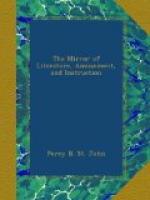“The males have generally a greyish or brown plumage, the feet of the turkey-cock, as also the beak, but a little more hooked. They have hardly any tail, and their posterior, covered with feathers, is rounded like the croup of a horse. They stand higher than the turkey-cock, and have a straight neck, a little longer in proportion than it is in that bird when it raises its head. The eye is black and lively, and the head without any crest or tuft. They do not fly, their wings being too short to support the weight of their bodies; they only use them in beating their sides, and in whirling round; when they wish to call one another, they make, with rapidity, twenty or thirty rounds in the same direction, during the space of four or five minutes; the movement of their wings then makes a noise which approaches exceedingly that of a kestrel (Crecerelle), and which is heard at more than 200 paces distant. The bone of the false pinion is enlarged at its extremity, and forms, under the feathers, a little round mass like a musket-bullet; this and their beak form the principal defence of this bird. It is extremely difficult to catch them in the woods; but as a man runs swifter than they, in the more open spots it is not very difficult to take them; sometimes they may even be approached very easily. From the month of March until September, they are extremely fat, and of most excellent flavour, especially when young. The males may be found up to the weight of 45 lb.; Herbert even says 50 lb.
“The female is of admirable beauty. Some are of a blond, others of a brown, colour; I mean by blond the colour of flaxen hair. They have a kind of band, like the bandeau of widows, above the beak, which is of a tan colour. One feather does not pass another over all their body, because they take great care to adjust and polish them with their beak. The feathers which accompany the thighs are rounded into a shell-like form, and, as they are very dense at this place, produce a very agreeable effect. They have two elevations over the crop, of a somewhat whiter plumage than the rest, and which resemble wonderfully the fine breast of a woman. They walk with so much stateliness and grace combined, that it is impossible not to admire and love them; so much so, that their appearance has often saved their life.
“Although these birds approach, at times, very familiarly when they are not chased, they are incapable of being tamed; as soon as caught, they drop tears, without crying, and refuse obstinately all kind of nourishment, until at last they die. There is always found in their gizzard (as well as in that of the males) a brown stone, the size of a hen’s egg; it is slightly tuberculated (raboteuse), flat on one side, and rounded on the other, very heavy and very hard. We imagined that this stone was born with them, because, however young they might be, they always had it, and never more than one; and besides this circumstance, the canal which passes from the crop to the gizzard, is by one-half too small to give passage to such a mass. We used them, in preference to any other stone, to sharpen our knives.




